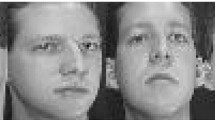Abstract
In this paper, a novel CCA-based dimensionality reduction method called generalized fuzzy canonical correlation analysis (GFCCA) is proposed. GFCCA combines the generalized canonical correlation analysis and fuzzy set theory. GFCCA redefines the fuzzy between-class and within-class scatter matrices that relate directly to the samples distribution information. For nonlinear separated problems, we extend the kernel extension of GFCCA with positive definite kernels and indefinite kernels. Experiments on real-world data sets are performed to test and evaluate the effectiveness of the proposed algorithms.






Similar content being viewed by others
References
Hel-Or Y (2004) The canonical correlations of color images and their use for demosaicing. HP Labs Technical Report, HPL-2003-164(R.1), Feb 2004
Loog M, van Ginneken B, Duin RPW (2005) Dimensionality reduction of image features using the canonical contextual correlation projection. Pattern Recognit 38:2409–2418
Yuan YH, Sun QS (2014) Multiset canonical correlations using globality preserving projections with applications to feature extraction and recognition. IEEE Trans Neural Netw Learn Syst 25(6):1131–1146
Nielsen AA (2002) Multiset canonical correlations analysis and multispectral, truly multitemporal remote sensing data. IEEE Trans Image Process 11:293–305
Yuan YH, Sun QS, Ge HW (2014) Fractional-order embedding canonical correlation analysis and its applications to multi-view dimensionality reduction and recognition. Pattern Recognit 47:1411–1424
Hardoon DR, Szedmak S, Shawe-Taylor J (2004) Canonical correlation analysis: an overview with application to learning methods. Neural Comput 16:2639–2664
Yuan YH, Li Y et al (2017) Laplacian multiset canonical correlations for multiview feature extraction and image recognition. Multimed Tools Appl 76(1):731–755
Wang F, Zhang D (2013) A new locality-preserving canonical correlation analysis algorithm for multi-view dimensionality reduction. Neural Process Lett 37(2):135–146
Peng Y, Zhang D, Zhang J (2010) A new canonical correlation analysis algorithm with local discrimination. Neural Process Lett 31(1):1–15
Melzer T, Reiter M, Bischof H (2003) Appearance models based on kernel canonical correlation analysis. Pattern Recognit 36:1961–1971
Kidron E, Schechner YY, Elad M (2005) Pixels that sound. IEEE Proc Comput Vis Pattern Recognit 1:88–95
Fortuna B (2004) Kernel canonical correlation analysis with applications, In: SIKDD, at Multiconference IS 2004, 12–15 Oct 2004. Ljubljana, Slovenia
Shawe-Taylor J, Cristianini N (2004) Kernel methods for pattern analysis. Cambridge University Press, Cambridge
Sun T, Chen S, Yang J, et al. (2008) A supervised combined feature extraction method for recognition. Proceedings of the IEEE International Conference on Data Mining. Pisa, Italy, pp 1043–1048
Sun Q-S, Liu Z-D, Heng P-A, Xia D-S (2005) A theorem on the generalized canonical projective vectors. Pattern Recognit 38:449–452
Yang J, Fan LY (2014) A novel indefinite kernel dimensionality reduction algorithm: weighted generalized indefinite kernel discriminant analysis. Neural Process Lett 40:301–313
Pekalska E, Haasdonk B (2009) Kernel discriminant analysis for positive definite and indefinite kernels. IEEE Trans Pattern Anal Mach Intell 31(6):1017–1032
Zheng W, Zou C, Zhao L (2005) An improved algorithm for kernel principal component analysis. Neural Process Lett 22(1):49–56
Haasdonk B (2005) Feature space interpretation of SVMs with indefinite kernels. IEEE Trans Pattern Anal Mach Intell 27(4):482–492
Keller JM, Gray MR, Givern JA (1985) A fuzzy k-nearest neighbour algorithm. IEEE Trans Syst Man Cybern 15(4):580–585
Cui Y, Fan Liya (2012) Feature extraction using fuzzy maximum margin criterion. Neurocomputing 86:52–58
Yang W, Wang J et al (2009) Feature extraction using fuzzy inverse FDA. Neurocomputing 72:3384–3390
Kwak K-C, Pedrycz W (2005) Face recognition using a fuzzy fisherface classifier. Pattern Recognit 38:1717–1732
Schölkopf B, Herbrich R, Smola A, (2001) A generalized representer theorem, Lecture Notes in Computer Science 2111:416–426
Goldfarb L (1985) A new approach to pattern recognition. Pattern Recognit 2:241–402
Yang J, Fan L (2012) Weighted generalized indefinite kernel discriminant analysis using fuzzy memberships. J Shandong Univ (Eng Sci) 42(3):31–38
Pekalska E, Duin R (2005) The dissimilarity representation for pattern recognition. Foundations and applications. World Scientific, 2005
Bognar J (1974) Indefinite inner product space. Springer, Berlin
Sun Tingkai, Chen Songcan (2007) Class label versus sample label-based CCA. Appl Math Comput 185:272–283
Jain AK, Duin RPW, Mao J (2000) Statistical pattern recognition: a review. IEEE Trans Pattern Anal Mach Intell 22(1):4–37
Acknowledgements
This work is supported by National Natural Science Foundation of China (61273251, 61673220).
Author information
Authors and Affiliations
Corresponding author
Rights and permissions
About this article
Cite this article
Yang, J., Sun, QS. A Novel Generalized Fuzzy Canonical Correlation Analysis Framework for Feature Fusion and Recognition. Neural Process Lett 46, 521–536 (2017). https://doi.org/10.1007/s11063-017-9600-z
Published:
Issue Date:
DOI: https://doi.org/10.1007/s11063-017-9600-z




